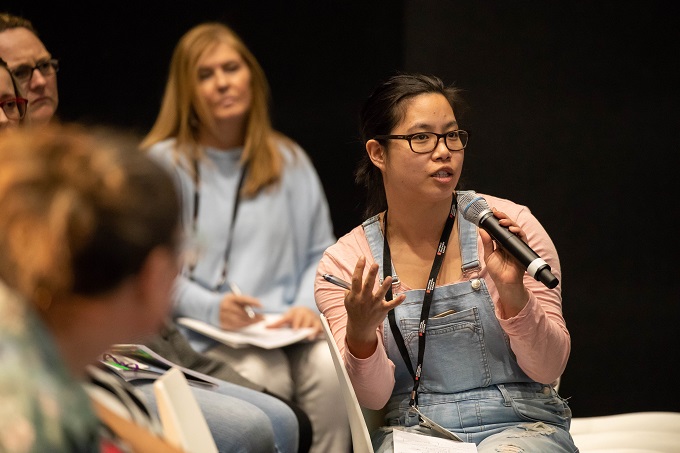Anxiety, ASD and meeting special student needs

Recent estimates suggest one-in-70 Australians have an autism spectrum disorder while anxiety is the most common mental health condition in the country.

Teaching students with ASD, anxiety or both can be challenging and confusing for educators. School News relished the opportunity to interview two experts on anxiety and ASD in the classroom to get some insight.
This article was published in our Term 1 issue of School News! Did you receive your copy? Click here to read online.
Caitlin Nathanson is a social worker and lecturer at the University of Queensland, who first took us through some of the misconceptions about students with ASD.
“A misconception I encountered working in schools as an ASD consultant was that students with ASD were in control during a meltdown and were just ‘tantruming’ or being ‘manipulative’.
“Meltdowns are the result of a complete loss of control. During a meltdown students are operating from their “downstairs brain” (Siegel, 2012) and need to be provided with sensitive and appropriate support from school staff to manage during a meltdown and as they recover from one. Schools should take a proactive approach by teaching students with ASD about emotional regulation, using tools like the ‘Five Point Scale’; teaching students to recognise when they are becoming dysregulated and providing a break space for students with calming tools to use.

Misconceptions about students with anxiety.
Teacher and neuro-developmental therapist, Ebony Birch-Hanger explained that “the absence of panic attacks does not mean an absence of anxiety”. She notes that anxiety is too often conflated with depression but anxiety can manifest even when the person seems happy.
“If you notice signs of anxiety in any of the students in the class/es you’re teaching; ask the student, ‘what do you need?” rather than, ‘how can I help?’. This is because the word ‘help’ may trigger a sense of helplessness and therefore refusal of assistance. If they can’t answer, provide some options: a chat with you, a break in the classroom, a break outside the classroom, time to chat with a friend, support from another teacher, a different learning task.”
Another misconception surrounding anxiety that Ebony has noticed, is that students are aware of their own anxiety and are therefore likely already being given help/support. “It is logical to assume that if a student is experiencing anxiety and it is affecting how they function, they must be aware of it and/or have sought help. However, as teachers, it’s important to know this is not always the case.
“I have worked with many students who know that they just don’t feel ‘right’ or comfortable, but don’t have the word – ‘anxiety’, to explain it. There are also students who are unable to identify anxiety in themselves, even if they understand what anxiety is and can identify it in others. This can sometimes stem from difficulties with interoception – the brain’s ability to interpret and identify physical sensations in the body. In these cases, students don’t recognise the warning signs their bodies may be giving them.
Holding a supportive space for students with ASD
Teachers should band together and create some momentum within their school. “They can develop an individualised plan for each student with ASD in collaboration with the student that identifies their triggers, where the student can go to keep themselves and others safe, the calming strategies that work for the individual student and the key staff that will respond and provide support,” Caitlin advises.
“In my PhD research, ‘Square pegs in round holes: The mainstream schooling experiences of students with an Autism Spectrum Disorder and their parents’, students with ASD did not report experiencing inclusion in mainstream schools; rather, they experienced standing out in mainstream schools.
“They experienced a sense of belonging in an ASD-specific education setting. Inclusion is so much more complex than simply placing students with special needs in mainstream environments. It requires a complete reorganisation of pedagogical practices in traditional classrooms and of how schools are funded.
“This is not to say that mainstream schools can’t provide individualised support for students with ASD. They can and should be doing so as they have a legislative and ethical requirement to practice inclusion. However, true inclusion is complex to achieve in practice.
“There are systemic issues and teachers are on the frontline having to manage with a lack ASD specific training, and inadequate resource provision in mainstream classrooms to support the complex and varying needs of all their learners. Teachers cannot address systemic issues themselves but at an individual level, they could consider using ‘Universal Design for Learning’ to optimise learning for all students.”

Navigating anxiety in higher versus lower achieving students
Ebony says: “Anxiety can and does occur in both higher and lower-achieving students: I would approach these students differently on the one hand but exactly the same on the other. It’s often easier as a teacher to recognise when a lower-achieving student needs support and completely miss signs in a higher-achieving student.
“Even once a teacher recognises a higher-achieving student is anxious, it’s easy to think that they won’t need as much support as others because they appear more capable of managing the anxiety. Usually this is not the case.”
Ebony explains that it’s important to identify what’s triggering the anxiety so you can organise the right support. For lower-achieving students: Offer assistance without waiting to be asked; remind them that you are also evaluating their effort and a grade isn’t a measure of how intelligent they are as a person; and, foster positive self-talk by modelling it for them.”
For higher-achieving students with anxiety, she says: “Make sure they know exactly what is required to achieve a particular grade; check progress and let them know when they’ve already met the requirements and therefore don’t need to do any further work; check how they are managing their deadlines and offer extensions for a specific amount of time, to minimise their anxiety around not meeting them.”
To register for the Special Needs Symposium in Brisbane or Melbourne and find out more, head to: www.nationaleducationsummit.com.au/brisbane-special-needs-symposium







